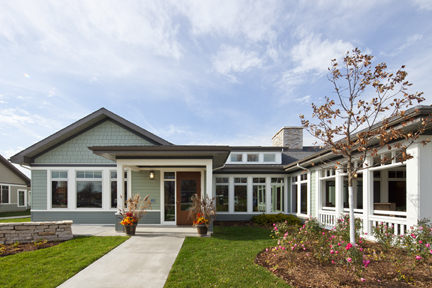The Chicago office of Perkins Eastman joins the U.S. Department of Veteran Affairs (VA) in announcing the country’s first Community Living Center (CLC) to utilize the Green House Prototype Design Package at the VA Illiana Health Care System campus in Danville, Ill.
The CLC at Danville consists of two 7,500 sf buildings—named Freedom House and Liberty House—containing ten private bedrooms with direct views to common areas, communal living areas and kitchens, and ample outdoor space, all with an aim to restore maximum function and independence while providing veteran-centered care.
The VA Illiana Health Care System CLC is the first of several VA communities either planned or under construction that utilizes the Green House Prototype Design Package, a new approach for seniors needing skilled nursing care that emphasizes de-institutionalization. The prototype was designed in 2011 by Perkins Eastman in concert with the Green House Project and NCB Capital Impact to provide a turnkey design for senior living communities at a reduced schedule and with reduced costs. The overall goal of design is to empower more providers across the country to create communities where seniors can experience quality care in a de-institutionalized environment.
A transformation in the way veteran care is delivered, Freedom House and Liberty House address the spectrum of health—physical, emotional, psychological—in their design. In adopting this community-based model of care, Freedom House and Liberty House at VA Illiana provide greater assurances of privacy and personalized environments for veterans in ways more traditional models cannot.
Perkins Eastman also designed six CLC buildings at the Captain James A. Lovell Federal Health Center in North Chicago, Ill., the first phase of which consists of two Green House Prototype buildings currently under construction to complete this summer. The second phase consists of four CLC buildings currently in design. BD+C
Related Stories
| Dec 8, 2014
How brick and mortar enables online retail
According to a shopping preferences study conducted by A.T. Kearney, as many as two-thirds of shoppers go to a physical store before or after making an online purchase, writes Gensler's Jill Nickels.
| Dec 8, 2014
The year’s boldest BIM/VDC themes
High-speed rendering software, custom APIs, virtual reality tools, and BIM workflow tips were among the hottest BIM/VDC topics in 2014.
| Dec 8, 2014
AEC firms upbeat about financial results, 2015 looking rosier [exclusive BD+C survey]
The market outlook is brighter for U.S. architecture, engineering, and construction companies, with a majority of AEC firms reporting higher revenues, strong forecasts, and sound financial health, according to BD+C's annual Market Forecast Survey.
| Dec 8, 2014
The global sanitation crisis leads to 2.5 million deaths every year
When we see the incredible technology being produced by global plumbing manufacturers, it’s hard to conceive why no viable technical solution to the global sanitation issue has come forth, writes BD+C's Robert Cassidy.
| Dec 8, 2014
Moshe Safdie wants to reinvent airports with Jewel Changi Airport addition
A new addition to Singapore's Changi Airport, designed by Moshe Safdie, will feature a waterfall and extensive indoor gardens.
| Dec 6, 2014
Future workplace designs shouldn’t need to favor one generation over another, says CBRE report
A new CBRE survey finds that what Millennials expect and need from offices doesn’t vary drastically from tenured employees.
| Dec 5, 2014
Plotting on the go: 3D-printed mechanical compass can print CAD drawings with high precision
Design student Ken Nakagaki has adapted a device to work with CAD software to replicate digital files on paper.
Sponsored | | Dec 5, 2014
New construction outlook report projects growth in 2015
A new 2015 construction outlook report predicts that total U.S. construction starts for 2015 will rise 9% to $612 billion. SPONSORED CONTENT
Sponsored | | Dec 5, 2014
Best practices for force transfer around openings
As wood-frame construction is continuously evolving, designers in many parts of the U.S. are optimizing design solutions that require the understanding of force transfer between elements in the lateral load-resisting system.

















